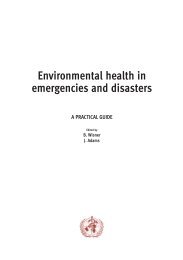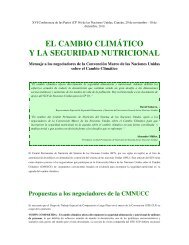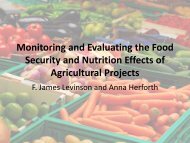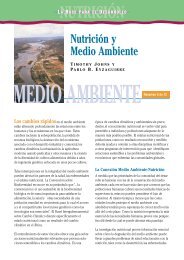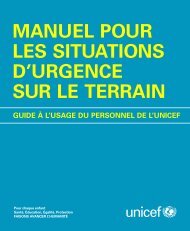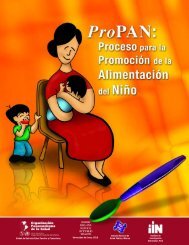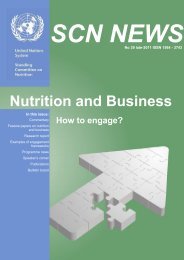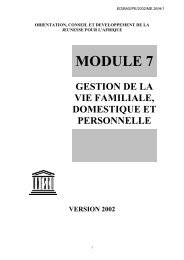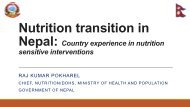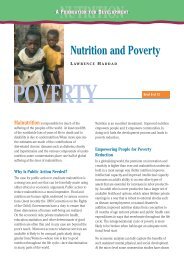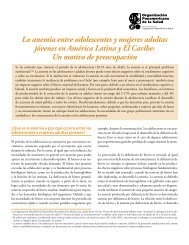SCN News No 36 - UNSCN
SCN News No 36 - UNSCN
SCN News No 36 - UNSCN
Create successful ePaper yourself
Turn your PDF publications into a flip-book with our unique Google optimized e-Paper software.
56<br />
35 TH <strong>SCN</strong> SESSION RECOMMENDATIONS www.unsystem.org/scn<br />
coordinate the delivery of humanitarian aid in emergency situations. Similar scales for use in non-emergency settings have yet to be developed<br />
however. The Food and Nutrition Technical Assistance (FANTA) website is also a good source of guidance on the measurement<br />
of food security work as used to guide USAID technical assistance to Title II emergency programs and more than 80 development,<br />
nutrition, and food security programs in 27 countries (online).<br />
24. Programme guidance on when and how to provide balanced energy-protein supplements to mothers during pregnancy is not readily<br />
available. The LNS Paper 3 used a cut off of 10% for excessive thinness (i.e. with a BMI less than 18.5) in women of reproductive age,<br />
in order to model the effects of the intervention. Improving maternal nutrition status to improve foetal development is not simply a<br />
question of improving dietary intake however as has been reported by several technical consultations. See WHO (2003) Promoting optimal<br />
fetal development: Report of a technical consultation. WHO:Geneva (online), ACC/<strong>SCN</strong> (2000) Low Birth Weight. Nutrition Policy Paper <strong>No</strong> 18.<br />
Standing Committee on Nutrition:Geneva (online).<br />
25. LNS paper 3 considers that in areas of food insecurity efforts to improve complementary feeding requires the provision of food<br />
supplements. Operational guidance exists on infant and young child feeding in emergency situations; see IFE Core Group (2007) Infant<br />
and Young Child Feeding in Emergencies: Operational Guidance for Emergency Relief Staff and Programme Managers. Version 2.1 – February 2007<br />
(online). Guidance on when and how to use food supplements in children 6-24 months in non-emergency situations in food insecure<br />
areas is less easy to find.<br />
26. The programmatic guidelines on the use of cash assistance that are available are more applicable to emergency situations than regular<br />
development settings (online). For a review of cash assistance use in more regular development settings; see Chapman K (2006)<br />
Using social transfers to scale up equitable access to education and health services. DFID Background Paper, London (online).<br />
27. Guidelines exist on how to control malaria infections that will contribute of improved maternal and child nutrition; see Roll Back<br />
Malaria (2008) Malaria in pregnancy. Infosheet (online).<br />
28. Guidelines on preventive chemotherapy for the control of helminth infections in humans is available for health programme managers;<br />
see WHO (2006) Preventive chemotherapy in human helminthiasis. Coordinated use of anthelminthic drugs in control interventions: a manual for health<br />
professionals and programme managers (online). Specific guidelines also exist for use of chemotherapy during pregnancy and lactation and in<br />
young children; see WHO (2002) Report of the WHO Informal Consultation on the use of Praziquantel during Pregnancy/Lactation and Albendazole/<br />
Mebendazole in Children under 24 months (online).<br />
29. The LNS includes hand washing and hygiene interventions among the core measures that reduces the risk of diarrhoea, under the<br />
assumption that these reductions contribute to reduce stunting. While it is recognized that reducing diarrhoeal diseases rates are not<br />
necessarily associated with improvements in child growth (Poskitt EM, Cole TJ, Whitehead RG (1999) Less diarrhoea but no change in<br />
growth: 15 years' data from three Gambian villages. Arch Dis Child. 80(2):115-9), the hygiene and hand washing dimensions of complementary<br />
food preparation are an important part of the child “care” component of nutrition programmes. This is especially so in areas<br />
where water and sanitation measures are poor. Programme guidelines exist on hand washing and hygiene, such as those described under<br />
the UNICEF WASH Strategies (online).<br />
30. Haddad L, Alderman H, Appleton S, Song L and Yohannes Y (2003) Reducing Child Malnutrition: How Far Does Income Growth<br />
Take Us? The World Bank Economic Review 17(1) 107-31.<br />
31. The World Bank publication Repositioning Nutrition as Central to Development: A Strategy for Large-Scale Action from 2006 makes the case<br />
that development partners and developing countries must increase investment in nutrition programs, and proposes to the international<br />
development community and national governments a global strategy for accelerated action in nutrition. Full report and executive summary<br />
in several languages are available online.<br />
32. The LNS did not include any interventions related to improved maternal care, although they agreed that there is evidence that too<br />
many pregnancies as well as smoking during pregnancy and exposure to household smoke could all have a negative impact on maternal<br />
health as well as foetal growth. Programming guidance on how to improve maternal care is provided in the UNICEF Care Initiative,<br />
(UNICEF (1997) The Care Initiative: Assessment, Analysis and Action to Improve Care for Nutrition. UNICEF:New York), which is explained in<br />
the <strong>SCN</strong> Nutrition Policy Paper <strong>No</strong> 18 on Low Birth Weight (online).<br />
33. The results of this work in progress will be posted at the WHO Nutrition for Health and Development webpage www.who.int/nutrition<br />
34. Important advocacy tools include the executive summaries of the LNS available in English and French, and of the World Bank Repositioning<br />
Nutrition as Central to Development available in English, French, Spanish and Chinese, referenced in notes 1 and 27 above, respectively.<br />
35. Important advocacy tools for national implementation of the right to food, for example, is available from the FAO Right to Food<br />
resources page at www.fao.org/righttofood/publi_en.htm, along with other material.<br />
<strong>36</strong>. FAO has established a webpage on the issue of increasing food prices www.fao.org/worldfoodsituation/wfs-home, and the topic was in<br />
focus at the High-Level Conference on World Food Security: the Challenges of Climate Change and Bioenergy 3-5 June 2008.<br />
37. Programme guidance for nutrition in emergency situations is available through the Toolkit for Addressing Nutrition in Emergency Situations<br />
produced by the Nutrition Cluster of the Inter Agency Standing Committee (online).<br />
38. The <strong>SCN</strong> Task Force on Assessment, Monitoring & Evaluation (March 2008) has recommended that for monitoring the progress<br />
made towards the achievement of MDG1, both countries and development partners report against the prevalence of stunting in children<br />
below the age of five as an internationally agreed indicator of endemic poverty. Furthermore stunting should be used as an additional<br />
indicator of endemic poverty to monitor progress made towards the achievement of MDG1 (online).<br />
39. Other sources of programme guidance include the Basics Nutrition Essentials, the World Bank Nutrition Tool Kit and the <strong>SCN</strong> Nutrition<br />
Policy Paper <strong>No</strong> 19 What Works?. The latter was developed for use in Asia with the purpose of defining for the Asian Development<br />
Bank a core menu of proven investment options supported by sound evidence of efficacy (online). Nutrition Essentials is a guide<br />
for health managers in developing countries, and was produced in the late nineties by Basics in collaboration with UNICEF and WHO<br />
(online). The World Bank' “Nutrition Toolkit” is aimed at helping World Bank staff design and supervise effective and feasible nutrition<br />
projects and project components and to carry out comprehensive analysis of sectoral and policy issues affecting nutrition. The<br />
documentation is comprehensive covering project design, basic facts on nutrition through to programme communication (online).




